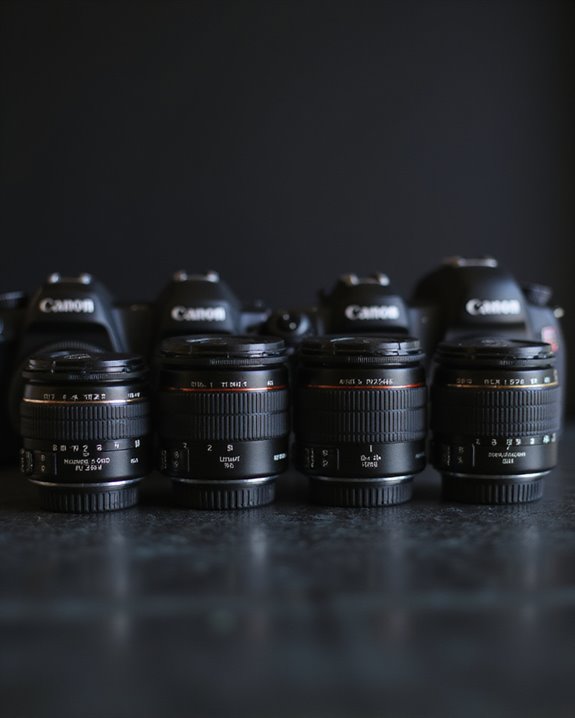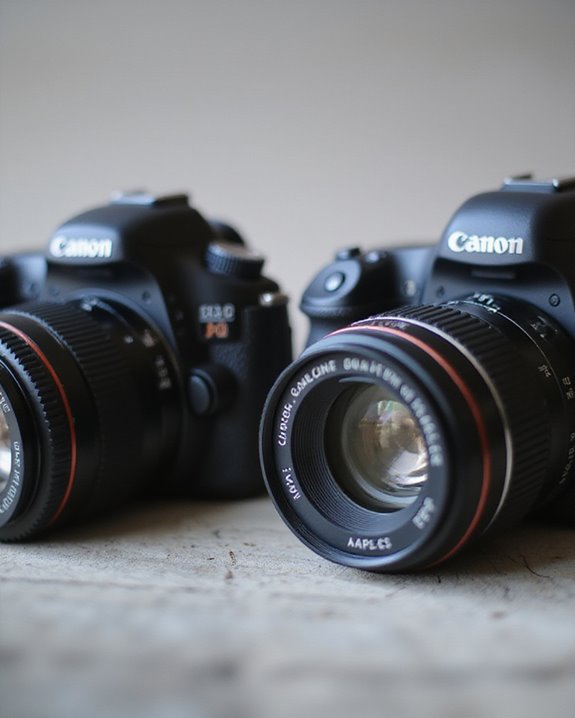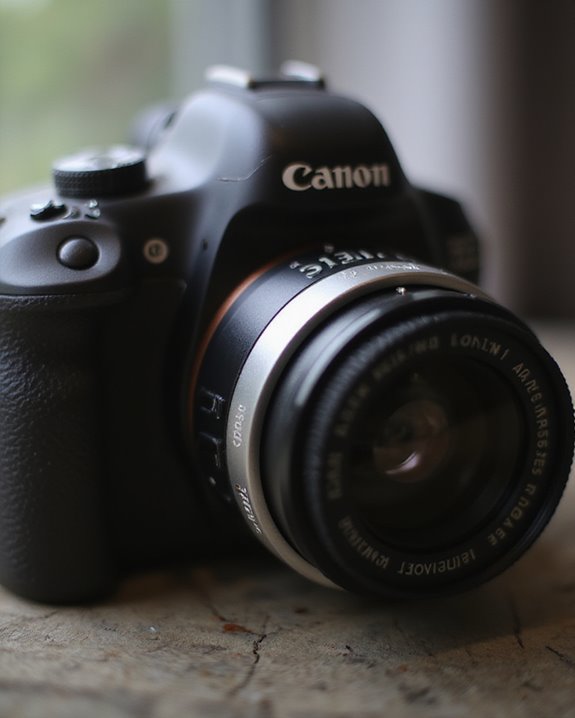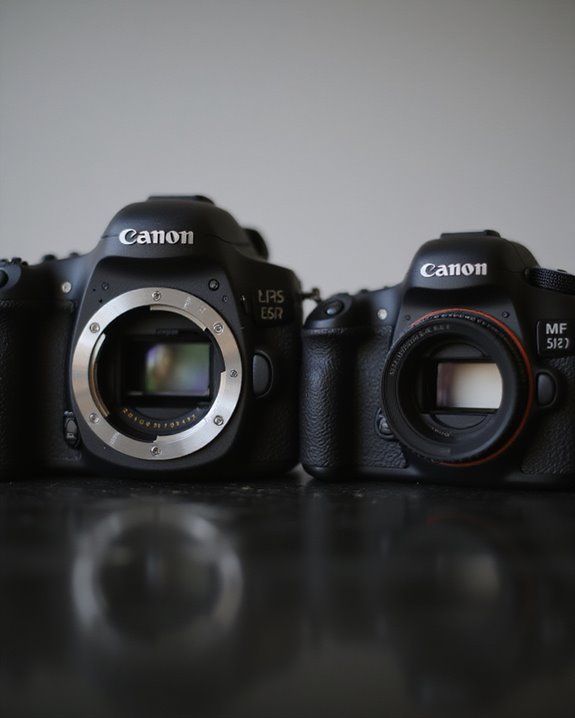No, not all Canon lenses fit all Canon cameras due to the company’s four distinct mount systems: EF, EF-S, EF-M, and RF. EF lenses work on all DSLRs, but EF-S lenses only fit APS-C bodies. Mirrorless cameras use either EF-M or RF mounts, which require adapters for DSLR lenses. The compatibility depends on your camera’s sensor size and mount type, with potential crop factors affecting focal length. Understanding these mount differences guarantees you’ll make informed lens investments.
Key Takeaways
- No, Canon lenses are not universally compatible across all Canon cameras due to different mount systems (EF, EF-S, EF-M, RF).
- EF lenses work on all Canon DSLRs but EF-S lenses only fit APS-C sensor Canon cameras, not full-frame models.
- Canon’s RF mount (mirrorless) cameras can use EF/EF-S lenses with an adapter but cannot directly mount them without one.
- EF-M lenses designed for Canon’s compact mirrorless cameras are incompatible with DSLR or RF-mount mirrorless cameras.
- The physical mount design and image circle size determine compatibility, with adapters offering solutions for some combinations.
Heading List for “Do All Canon Lens Fit All Canon Cameras”
When exploring Canon’s ecosystem of cameras and lenses, we’re confronted with a complex compatibility matrix that requires careful consideration before making purchasing decisions. Understanding these relationships is essential for maximizing both functionality and Lens Quality while evaluating Canon against Brand Alternatives. To navigate this complexity, we’ve organized this article into five essential sections: Introduction to Canon Mount Types (EF, EF-S, RF, EF-M), DSLR Camera Compatibility Analysis, Mirrorless System Integration, Limitations and Technical Considerations, and Future Trends in Canon’s Optical Systems. Each section addresses specific compatibility questions that photographers face when building their kit, examining how different lens mounts interact with various camera bodies, the implications of the 1.6x crop factor on APS-C sensors, and the migration path from legacy systems to Canon’s cutting-edge RF mount architecture. Additionally, understanding lens mount compatibility is crucial for ensuring seamless integration across different Canon camera models, especially as the company continues to innovate and phase out older systems.
Understanding Canon’s Four Mount Types

The evolution of Canon’s lens mount systems represents a critical technological progression that photographers must grasp to make informed equipment decisions. Throughout Canon’s Mount History, we’ve seen the development of four distinct systems: EF (1987) for DSLRs, EF-S (2003) for APS-C DSLRs, EF-M (2012) for the compact mirrorless M series, and the latest RF mount for full-frame mirrorless cameras. Each represents significant Design Innovations, with the RF mount featuring a larger diameter and shorter flange distance than its predecessors, enabling superior optical performance. The EF mount works universally with Canon DSLRs, while EF-S lenses are limited to APS-C bodies. EF-M lenses serve exclusively on M-series cameras, and the RF mount accommodates both RF and RF-S lenses, with adapters available for legacy EF glass. Sensor size and mount compatibility are critical considerations for ensuring optimal camera performance and lens versatility.
Full-Frame vs. APS-C Compatibility Rules

Understanding compatibility rules between Canon’s full-frame and APS-C systems is essential for photographers who want to build a coherent lens collection. The fundamental principle revolves around the Image Circle projected by each lens type relative to sensor dimensions. EF lenses produce larger image circles that completely cover both sensor formats, making them universally compatible across Canon’s DSLR lineup. Conversely, EF-S lenses project smaller image circles suitable only for APS-C sensors and cannot physically mount on full-frame bodies due to potential mechanical interference. When using EF lenses on APS-C cameras, the 1.6x Crop Factor comes into play, effectively extending the perceived focal length. For example, a 50mm EF lens delivers an 80mm equivalent field of view on APS-C bodies, providing a telephoto advantage often beneficial for wildlife and sports photography. Additionally, lens mounting compatibility depends on the lens mount design, which ensures proper fit and functionality across different camera models.
Using Adapters to Expand Lens Compatibility

As photography gear evolves, Canon’s adapter ecosystem has become an essential bridge between traditional DSLR lenses and modern mirrorless bodies, allowing photographers to leverage their existing lens investments across multiple systems. The EF-EOS R adapters maintain full electronic communication, ensuring native autofocus speeds, image stabilization, and complete EXIF data transmission without sacrificing image quality, as they contain no optical elements.
Advanced options like the Control Ring Adapter provide customizable parameter adjustments for ISO, aperture, or shutter speed, enhancing workflow efficiency. These adapters support regular Firmware Updates via the camera body, ensuring continued compatibility as technology advances. Weather-sealed models preserve the environmental protection of professional setups, while specialized variants like the drop-in filter adapters offer additional creative possibilities, maintaining Canon’s commitment to system flexibility across generations of equipment.
Identifying Your Camera’s Mount System

When diving into Canon’s ecosystem of interchangeable lenses, correctly identifying your camera’s mount system becomes the critical first step for ensuring proper lens compatibility. We recommend examining your camera’s body for distinctive mount characteristics, as each Canon mount type—EF, EF-S, EF-M, RF, and RF-S—exhibits unique physical attributes. Consulting Mount Diagrams in your camera’s manual can instantly clarify which system you’re working with, particularly for those unfamiliar with the visual differences between mount types. Label Reading is equally essential; Canon typically includes mount information directly on the camera body near the lens mount or within the specifications section of your manual. Full-frame DSLRs utilize EF mounts exclusively, while crop-sensor models accept both EF and EF-S lenses, and R-series cameras employ the newer RF mount system.
Frequently Asked Questions
Can Vintage FD Mount Lenses Work With Modern Canon Cameras?
Like antique keys to modern locks, we won’t see FD lenses directly fit new Canon cameras. We’ll need adapters for mirrorless systems to unleash their Vintage Appeal and Historical Value on today’s digital bodies.
Do Third-Party Lenses Follow the Same Compatibility Rules as Canon’s?
Yes, third-party lenses generally follow Canon’s mount compatibility rules, but there can be issues with firmware compatibility and licensing agreements. We’ve seen some manufacturers occasionally face limitations when Canon updates their cameras.
Will Using Adapters Affect Image Stabilization or Autofocus Performance?
Isn’t it ironic? Just when we’re trying to save money with adapters, we’re risking performance. Yes, they’ll affect both – adapter quality directly influences stabilization impact and autofocus speed. We’ve seen consistent limitations with most setups.
How Does Using EF Lenses on Crop Sensors Affect Depth of Field?
When we use EF lenses on crop sensors, we get greater depth of field for the same composition. Focal Adjustment is needed due to the crop factor, creating this Sensor Comparison difference in background blur.
Can Cinema EOS Lenses Be Used on Consumer Canon Cameras?
Like a perfect match, we can confirm Cinema EOS lenses work on consumer Canon cameras with EF mounts. You’ll enjoy their superb dynamic range and color science, though they’re bulkier and pricier than standard lenses.





